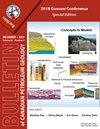The Garbutt Formation of Liard Basin, British Columbia: a potential liquids-rich play
Q3 Earth and Planetary Sciences
引用次数: 5
Abstract
Abstract In Liard Basin of northern British Columbia, syn-depositional motion on the Bovie structure resulted in greater thicknesses of Cretaceous sediments. The Early Cretaceous Garbutt Formation was deposited during the initiation of a major marine transgression. Organic-rich shales and siltstones in its lower part record maximum flooding and have been informally termed the Radioactive Zone (RZ). The Garbutt Formation is dominated by shales and siltstones and is here subdivided into three informal units; the lower Garbutt Formation (LGF), the succeeding RZ and the upper Garbutt Formation (UGF). The combined thickness of the Radioactive Zone and lower Garbutt Formation is 40 to over 120 m thick and can be at greater than 2000 m depth in Liard Basin. The lower Garbutt Formation is not recognized east of the Bovie structure and the RZ is considerably thinner or absent locally, suggesting this area remained high relative to Liard Basin. Total organic carbon and Rock-Eval data suggest that the RZ is a good to very good source rock and that the LGF is also a good source rock. Organic matter is dominantly Type II kerogen, although more terrestrial Type III input becomes prevalent in western parts of the basin. Thermal maturity inferred from Tmax, in addition to hydrogen index levels, indicate that these rocks are in the oil window in northern Liard Basin and in the wet gas window within central Liard Basin. Porosities average 8% and matrix compositions average 39 wt.% quartz, 4 wt.% feldspar and calcite and 53 wt.% clays (illite/mica, kaolinite and chlorite). The properties of the RZ and LGF indicate that a potential liquids-rich shale gas play may occur within central Liard Basin.不列颠哥伦比亚省Liard盆地Garbutt组:一个潜在的富液油气藏
在不列颠哥伦比亚省北部的Liard盆地,Bovie构造的同沉积运动导致白垩纪沉积物厚度增大。早白垩世Garbutt组沉积于一次海侵起始期。其下部富含有机质的页岩和粉砂岩记录了最大的洪水,被非正式地称为放射性带(RZ)。Garbutt组以页岩和粉砂岩为主,在这里被细分为三个非正式单元;下Garbutt组(LGF)、后续RZ和上Garbutt组(UGF)。在Liard盆地,放射性带和下Garbutt组的总厚度在40 ~ 120 m以上,深度可达2000 m以上。Bovie构造以东没有下部Garbutt组,RZ相对较薄或局部不存在,表明该地区相对于Liard盆地仍然较高。总有机碳和岩石评价数据表明,RZ为好至极好烃源岩,LGF也为好烃源岩。盆地西部有机质以ⅱ型干酪根为主,陆相ⅲ型干酪根输入较多。热成熟度和氢指数水平表明,这些岩石位于利亚德盆地北部的含油窗和中部的湿气窗。孔隙率平均为8%,基质成分平均为石英39%,长石和方解石4%,粘土(伊利石/云母、高岭石和绿泥石)53%。RZ和LGF的特征表明,利亚德盆地中部可能发育富液页岩气。
本文章由计算机程序翻译,如有差异,请以英文原文为准。
求助全文
约1分钟内获得全文
求助全文
来源期刊

Bullentin of Canadian Petroleum Geology
Earth and Planetary Sciences-Geochemistry and Petrology
CiteScore
2.50
自引率
0.00%
发文量
0
期刊介绍:
The Bulletin of Canadian Petroleum Geology is a peer-reviewed scientific journal published four times a year. Founded in 1953, the BCPG aims to be the journal of record for papers dealing with all aspects of petroleum geology, broadly conceived, with a particularly (though not exclusively) Canadian focus. International submissions are encouraged, especially where a connection can be made to Canadian examples.
 求助内容:
求助内容: 应助结果提醒方式:
应助结果提醒方式:


